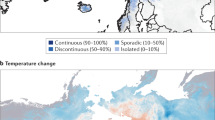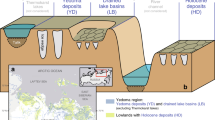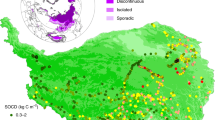Abstract
The permafrost zone is expected to be a substantial carbon source to the atmosphere, yet large-scale models currently only simulate gradual changes in seasonally thawed soil. Abrupt thaw will probably occur in <20% of the permafrost zone but could affect half of permafrost carbon through collapsing ground, rapid erosion and landslides. Here, we synthesize the best available information and develop inventory models to simulate abrupt thaw impacts on permafrost carbon balance. Emissions across 2.5 million km2 of abrupt thaw could provide a similar climate feedback as gradual thaw emissions from the entire 18 million km2 permafrost region under the warming projection of Representative Concentration Pathway 8.5. While models forecast that gradual thaw may lead to net ecosystem carbon uptake under projections of Representative Concentration Pathway 4.5, abrupt thaw emissions are likely to offset this potential carbon sink. Active hillslope erosional features will occupy 3% of abrupt thaw terrain by 2300 but emit one-third of abrupt thaw carbon losses. Thaw lakes and wetlands are methane hot spots but their carbon release is partially offset by slowly regrowing vegetation. After considering abrupt thaw stabilization, lake drainage and soil carbon uptake by vegetation regrowth, we conclude that models considering only gradual permafrost thaw are substantially underestimating carbon emissions from thawing permafrost.
This is a preview of subscription content, access via your institution
Access options
Access Nature and 54 other Nature Portfolio journals
Get Nature+, our best-value online-access subscription
$29.99 / 30 days
cancel any time
Subscribe to this journal
Receive 12 print issues and online access
$259.00 per year
only $21.58 per issue
Buy this article
- Purchase on Springer Link
- Instant access to full article PDF
Prices may be subject to local taxes which are calculated during checkout


Similar content being viewed by others
Data availability
All synthesized data used as model inputs, plus associated references, are provided in the Supplementary Data. Modelled data that support the findings of this study are also provided in the Supplementary Data.
Code availability
RMD files containing full code for the three generalized abrupt thaw models are available at https://github.com/mturetsky/Abrupt-thaw-carbon-model.
References
Schuur, E. A. G. et al. Climate change and the permafrost carbon feedback. Nature 520, 171–179 (2015).
McGuire, A. D. et al. Dependence of the evolution of carbon dynamics in the northern permafrost region on the trajectory of climate change. Proc. Natl Acad. Sci. USA 115, 3882–3887 (2018).
Hugelius, G. et al. Estimated stocks of circumpolar permafrost carbon with quantified uncertainty ranges and identified data gaps. Biogeosciences 11, 6573–6593 (2014).
Schuur, E. A. G., McGuire, A. D., Romanovsky, V., Schädel, C. & Mack, M. in Second State of the Carbon Cycle Report (SOCCR2): A Sustained Assessment Report (eds Cavallaro, N. et al.) 428–468 (US Global Change Research Program, 2018).
Schuur, E. A. G. et al. Vulnerability of permafrost carbon to climate change: implications for the global carbon cycle. Bioscience 58, 701–714 (2008).
Khvorostyanov, D. V. et al. Vulnerability of permafrost carbon to global warming. Part II: sensitivity of permafrost carbon stock to global warming. Tellus B Chem. Phys. Meteorol. 60, 265–275 (2007).
Tarnocai, C. The effect of climate warming on the carbon balance of cryosols in Canada. Permafrost Periglac. Process. 10, 251–263 (1999).
Zimov, S. A. et al. Permafrost carbon: stock and decomposability of a globally significant carbon pool. Geophys. Res. Lett. 33, L20502 (2006).
Schaefer, K., Lantuit, H., Romanovsky, V. E., Schuur, E. A. G. & Witt, R. The impact of the permafrost carbon feedback on global climate. Environ. Res. Lett. 9, 085003 (2014).
Abbott, B. W. et al. Biomass offsets little or none of permafrost carbon release from soils, streams, and wildfire: an expert assessment. Environ. Res. Lett. 11, 034014 (2016).
Lawrence, D. M., Koven, C. D., Swenson, S. C., Riley, W. J. & Slater, A. G. Permafrost thaw and resulting soil moisture changes regulate projected high-latitude CO2 and CH4 emissions. Environ. Res. Lett. 10, 094011 (2015).
Koven, C. D. et al. A simplified, data-constrained approach to estimate the permafrost carbon–climate feedback. Phil. Trans. R. Soc. A Math. Phys. Eng. Sci. 373, 20140423 (2015).
MacDougall, A. H., Avis, C. A. & Weaver, A. J. Significant existing commitment to warming from the permafrost carbon feedback. Nat. Geosci. 5, 719–721 (2012).
Olefeldt, D. et al. Circumpolar distribution and carbon storage of thermokarst landscapes. Nat. Commun. 7, 13043 (2016).
Grosse, G. et al. Vulnerability of high-latitude soil organic carbon in North America to disturbance. J. Geophys. Res. 116, G00K06 (2011).
Kokelj, S. V. & Jorgenson, M. T. Advances in thermokarst research. Permafrost Periglac. Process. 24, 108–119 (2013).
Walter Anthony, K. M. et al. A shift of thermokarst lakes from carbon sources to sinks during the holocene epoch. Nature 511, 452–456 (2014).
Walter Anthony, K. M. et al. 21st-century modeled permafrost carbon emissions accelerated by abrupt thaw beneath lakes. Nat. Commun. 9, 3262 (2018).
Schneider von Deimling, T. et al. Observation-based modelling of permafrost carbon fluxes with accounting for deep carbon deposits and thermokarst activity. Biogeosciences 12, 3469–3488 (2015).
Turetsky, M. R. et al. Permafrost collapse is accelerating carbon release. Nature 569, 32–34 (2019).
Houghton, R. A. et al. Changes in the carbon content of terrestrial biota and soils between 1860–1980. Ecol. Monogr. 53, 235–262 (1983).
Treat, C. C. et al. Effects of permafrost aggradation on peat properties as determined from a pan-Arctic synthesis of plant macrofossils. J. Geophys. Res. 121, 78–94 (2016).
Lewkowicz, A. G. & Way, R. G. Extremes of summer climate trigger thousands of thermokarst landslides in a High Arctic environment. Nat. Commun. 10, 1329 (2019).
Jones, M. K. W., Pollard, W. H. & Jones, B. M. Rapid initialization of retrogressive thaw slumps in the Canadian High Arctic and their response to climate and terrain factors. Environ. Res Lett. 14, 055006 (2019).
Farquharson, L. M. et al. Climate change drives widespread and rapid thermokarst development in very cold permafrost in the Canadian High Arctic. Geophys. Res. Lett. 46, 6681–6689 (2019).
Schädel, C. et al. Potential carbon emissions dominated by carbon dioxide from thawed permafrost soils. Nat. Clim. Change 6, 950–953 (2016).
Serikova, S. et al. High riverine CO2 emissions at the permafrost boundary of western Siberia. Nat. Geosci. 11, 825–829 (2018).
Vonk, J. E. et al. High biolability of ancient permafrost carbon upon thaw. Geophys. Res. Lett. 40, 2689–2693 (2013).
Sannel, A. B. K. & Kuhry, P. Warming-induced destabilization of peat plateau/thermokarst lake complexes. J. Geophys. Res. 116, G03035 (2011).
Schuur, E. A. G. et al. Expert assessment of vulnerability of permafrost carbon to climate change. Clim. Change 119, 359–374 (2013).
Kleinen, T. & Brovkin, V. Pathway-dependent fate of permafrost region carbon. Environ. Res. Lett. 13, 094001 (2018).
Rogelj, J. et al. in Special Report on Global Warming of 1.5 °C (eds Masson-Delmotte, V. et al.) 93–174 (WMO, 2018).
Balser, A. W., Jones, J. B. & Gens, R. Timing of retrogressive thaw slump initiation in the Noatak Basin, northwest Alaska, USA. J. Geophys. Res. 119, 1106–1120 (2014).
Loranty, M. M. et al. Reviews and syntheses: changing ecosystem influences on soil thermal regimes in northern high-latitude permafrost regions. Biogeosciences 15, 5287–5313 (2018).
Baltzer, J. L., Veness, T., Chasmer, L. E., Sniderhan, A. E. & Quinton, W. L. Forests on thawing permafrost: fragmentation, edge effects, and net forest loss. Glob. Change Biol. 20, 824–834 (2014).
Kokelj, S. V., Lantz, T. C., Tunnicliffe, J., Segal, R. & Lacelle, D. Climate-driven thaw of permafrost preserved glacial landscapes, northwestern Canada. Geology 45, 371–374 (2017).
Walter Anthony, K. M. et al. Methane emissions proportional to permafrost carbon thawed in arctic lakes since the 1950s. Nat. Geosci. 9, 679–682 (2016).
Petrenko, V. et al. Minimal geological methane emissions during the younger dryas–preboreal abrupt warming event. Nature 548, 443–446 (2017).
Beck, J. et al. Bipolar carbon and hydrogen isotope constraints on the Holocene methane budget. Biogeosciences 15, 7155–7175 (2018).
Kruse, S. et al. Dispersal distances and migration rates at the arctic treeline in Siberia—a genetic and simulation-based study. Biogeosciences 16, 1211–1224 (2019).
Nitze, I., Grosse, G., Jones, B. M., Romanovsky, V. E. & Boike, J. Remote sensing quantifies widespread abundance of permafrost region disturbances across the Arctic and Subarctic. Nat. Commun. 9, 5423 (2018).
Abbott, B. W., Jones, J. B., Godsey, S. E., Larouche, J. R. & Bowden, W. B. Patterns and persistence of hydrologic carbon and nutrient export from collapsing upland permafrost. Biogeosciences 12, 3725–3740 (2015).
Tanski, G. et al. Transformation of terrestrial organic matter along thermokarst-affected permafrost coasts in the Arctic. Sci. Total Environ. 581–582, 434–447 (2017).
Estop-Aragones, C. et al. Respiration of aged soil carbon during fall in permafrost peatlands enhanced by active layer deepening following wildfire but limited following thermokarst. Environ. Res. Lett. 13, 085002 (2018).
O’Donnell, J. A. et al. The effects of permafrost thaw on soil hydrologic, thermal, and carbon dynamics in an Alaskan peatland. Ecosystems 15, 213–229 (2012).
Jones, M. C. et al. Rapid carbon loss and slow recovery following permafrost thaw in boreal peatlands. Glob. Change Biol. 23, 1109–1127 (2017).
Soetaert, K. & Petzoldt, T. Inverse modeling, sensitivity, and Monte Carlo analysis in R using package FME. J. Stat. Softw. https://doi.org/10.18637/jss.v033.i03 (2010)..
Myhre, G. et al. in Climate Change 2013: The Physical Science Basis (eds Stocker, T. F. et al.) 659–740 (Cambridge Univ. Press, 2013).
Frolking, S. & Roulet, N. T. Holocene radiative forcing impact of northern peatland carbon accumulation and methane emissions. Glob. Change Biol. 13, 1079–1088 (2007).
Frolking, S., Roulet, N. & Fuglestvedt, J. How northern peatlands influence the Earth’s radiative budget: sustained methane emission versus sustained carbon sequestration. J. Geophys. Res. 111, G01008 (2006).
Acknowledgements
S. Frolking provided guidance on the radiative forcing calculations. M. Strimas-Mackey and A. McAdam provided assistance with the R coding. T. Douglas provided constructive feedback on the manuscript. This work is a product of the Permafrost Carbon Network and SEARCH Permafrost Action Team. We acknowledge support from NSERC (to M.R.T.), the PETA-CARB project (ERC number 338335) and BMBF KoPf project (to G.G.), and NSF ARCSS 1500931 and NASA ABoVE (to K.W.A.).
Author information
Authors and Affiliations
Contributions
M.R.T. and A.D.M. conceived of the study. B.W.A., M.C.J., K.W.A. and M.R.T. led the development of each abrupt thaw conceptual model. G.G. and C.G. participated in remote sensing analysis and synthesis. M.R.T., G.G. and K.W.A. led the synthesis of thaw lake data. M.R.T., M.C.J., D.O. and A.B.K.S. led the synthesis of permafrost peatland data. G.G. led the synthesis of head wall retreat rates. B.W.A. and E.A.G.S. led the synthesis of hillslope data. M.R.T. performed the simulations and wrote the paper. All authors commented on the analysis, interpretation and presentation of the data and were involved with the writing.
Corresponding author
Ethics declarations
Competing interests
The authors declare no competing interests.
Additional information
Peer review information Primary Handling Editors: Xujia Jiang; Heike Langenberg.
Publisher’s note Springer Nature remains neutral with regard to jurisdictional claims in published maps and institutional affiliations.
Supplementary information
Supplementary Information
Supplementary methods, Tables 1–6 and Figs. 1–8.
Rights and permissions
About this article
Cite this article
Turetsky, M.R., Abbott, B.W., Jones, M.C. et al. Carbon release through abrupt permafrost thaw. Nat. Geosci. 13, 138–143 (2020). https://doi.org/10.1038/s41561-019-0526-0
Received:
Accepted:
Published:
Issue Date:
DOI: https://doi.org/10.1038/s41561-019-0526-0
This article is cited by
-
Millennial-aged pyrogenic carbon in high-latitude mineral soils
Communications Earth & Environment (2024)
-
Accelerating thermokarst lake changes on the Qinghai–Tibetan Plateau
Scientific Reports (2024)
-
Post-fire stabilization of thaw-affected permafrost terrain in northern Alaska
Scientific Reports (2024)
-
Earth system models must include permafrost carbon processes
Nature Climate Change (2024)
-
River water quality shaped by land–river connectivity in a changing climate
Nature Climate Change (2024)



